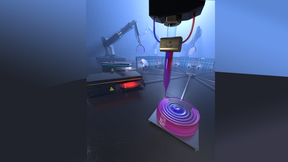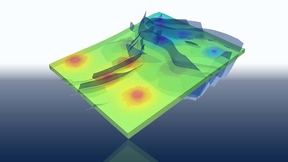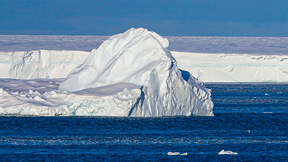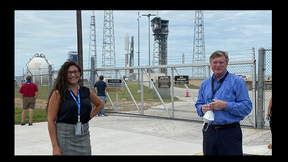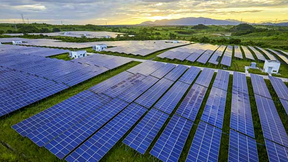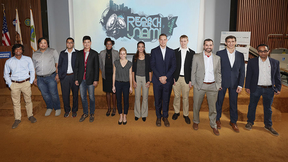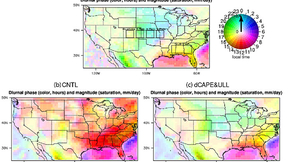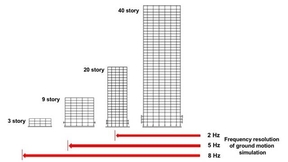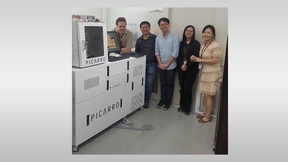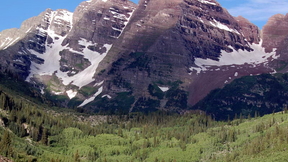Back
Lawrence Livermore National Laboratory (LLNL) researchers have used multi-material 3D printing to create tailored gradient refractive index glass optics that could make for better military specialized eyewear and virtual reality goggles. The new technique could achieve a variety of conventional and unconventional optical functions in a flat glass component (with no surface…
Two teams of Lawrence Livermore National Laboratory (LLNL) scientists and engineers, each supported by a Lab business development executive, have garnered regional awards for technology transfer. This year’s awards, one for outstanding technology development and the other for an outstanding partnership, will be presented next week during the Federal Laboratory Consortium’s…
After more than two years of joint research, Lawrence Livermore National Laboratory (LLNL), Total and Stanford University are releasing an open-source, high-performance simulator for large-scale geological carbon dioxide (CO2) storage. The GEOSX simulator will enable researchers around the world to build on the work of the three partners, providing an open framework to…
More than 150 girls logged into their computers, excited to participate in the first-ever virtual San Joaquin Expanding Your Horizons (SJEYH) conference via Zoom last month. Now in its 28th year, SJEYH has a long history of inspiring young women and fostering awareness of careers in science, technology, engineering and math (STEM). The annual event normally draws more than…
Lawrence Livermore National Laboratory (LLNL) geologist Lars Borg and physicist Megan Bruck Syal were named by the National Academies of Science to a pair of Planetary Science and Astrobiology Decadal Survey committees last week, Borg as a member of the survey’s steering committee and Syal as a member of the Small Solar System Bodies panel. Over the coming year, the two…
More than 50 percent of the world’s oceans already could be impacted by climate change, with this figure rising to 80 percent over the coming decades, a research team including Lawrence Livermore National Laboratory (LLNL) oceanographer Paul Durack has found, using global ocean salinity, temperature observations and a large suite of global climate models. The findings…
A Lawrence Livermore National Laboratory (LLNL) team has published new supercomputer simulations of a magnitude 7.0 earthquake on the Hayward Fault. This work represents the highest-ever resolution ground motion simulations from such an event on this scale. The study used the SW4 code developed at LLNL. Simulations resolved rapidly varying shaking with broader band…
When an Atlas V-541 rocket lifted off Thursday morning (July 30) for Mars from Cape Canaveral Air Force Station with the Perseverance rover in tow, two Lawrence Livermore National Laboratory (LLNL) scientists had front row seats. The pair, Steve Homann and Jessica Osuna, researchers in the Lab’s National Atmospheric Release Advisory Center (NARAC), part of the Nuclear…
Lawrence Livermore National Laboratory (LLNL) has updated its energy flow charts to include state-by-state energy use for 2015-2018. It also has released carbon emissions charts that depict a breakdown of all 50 states’ carbon emissions from 2014-2017. See the charts. Each year, LLNL releases flow charts that illustrate the nation's consumption and use of energy. This…
The most advanced and comprehensive analysis of climate sensitivity undertaken has revealed with more confidence than ever how sensitive the Earth’s climate is to carbon dioxide. Climate warming depends on the changing composition of the atmosphere, and the “climate sensitivity” represents the dominant indicator of change, defined as the increase of global air temperature…
Lawrence Livermore National Laboratory (LLNL) researchers, in collaboration with Pennsylvania State University (PSU) and Idaho National Laboratory (INL), have designed a new process, based on a naturally occurring protein, that could extract and purify rare earth elements (REE) from low-grade sources. It could offer a new avenue toward a more diversified and sustainable…
Stress wave propagation through granular material is important for detecting the magnitude of earthquakes, locating oil and gas reservoirs, designing acoustic insulation and designing materials for compacting powders. A team of researchers including Lawrence Livermore National Laboratory (LLNL) physicist Eric Herbold used X-ray measurements and analyses to show that…
A team of Lawrence Livermore National Laboratory (LLNL) scientists and collaborators from the University of California, Santa Cruz (UCSC) and Sun Yat-Sen University have developed a new class of aerogel electrodes with a simultaneous boost in energy and power density. The research could be a boon for the energy storage industry. “This is the first example in which we were…
On October 29, 2019, twelve Lawrence Livermore postdocs took to the stage, each with three slides and three minutes to answer the question: “Why is your research important?” The presentations, part of a yearly competition known as the Research Slam!, were a culmination of months of development, training, and practice. The 2019 program kicked off with seminars about…
Precipitation is one of the most challenging aspects of climate to model, so the accuracy with which it is represented is therefore frequently cited as a barometer for the quality of climate forecasting. A shortcoming in current climate models is their inability to accurately predict diurnal precipitation patterns. Over land, the daily precipitation cycle is strong: As the…
Critical to the success of high-performance, three-dimensional (3D) printed living materials is the development of new ink materials and 3D geometries that favor long-term cell functionality. To address this challenge, a cross-directorate LLNL team, collaborating with National Renewable Energy Laboratory researchers, has invented a new bio-ink system using viable freeze…
With unprecedented resolution, Lawrence Livermore and Lawrence Berkeley national laboratory scientists and engineers are simulating precisely how a large-magnitude earthquake along the Hayward Fault would affect different locations and buildings across the San Francisco Bay Area. The researchers reported on their recent simulations in June at the U.S. National Conference…
For the first time, scientists from Lawrence Livermore National Laboratory (LLNL) and five other organizations have shown that human influences significantly impact the size of the seasonal cycle of temperature in the lowest layer of the atmosphere. To demonstrate this, they applied a so-called "fingerprint" technique. Fingerprinting seeks to separate human and natural…
A commercial cavity ring-down spectroscopy (CRDS) instrument for the measurement of 14C in biological studies has been developed through a Cooperative Research and Development Agreement between Picarro, Inc. and Lawrence Livermore National Laboratory—where much of the initial research and development was performed. CRDS is a highly sensitive optical spectroscopic technique…
An international team of scientists, including one from Lawrence Livermore National Laboratory (LLNL), has found that up to 20 percent loss in the annual maximum amount of water contained in the Western United States’ mountain snowpack in the last three decades is due to human influence. Peak runoff in streams and rivers of the Western U.S. is strongly influenced by…

